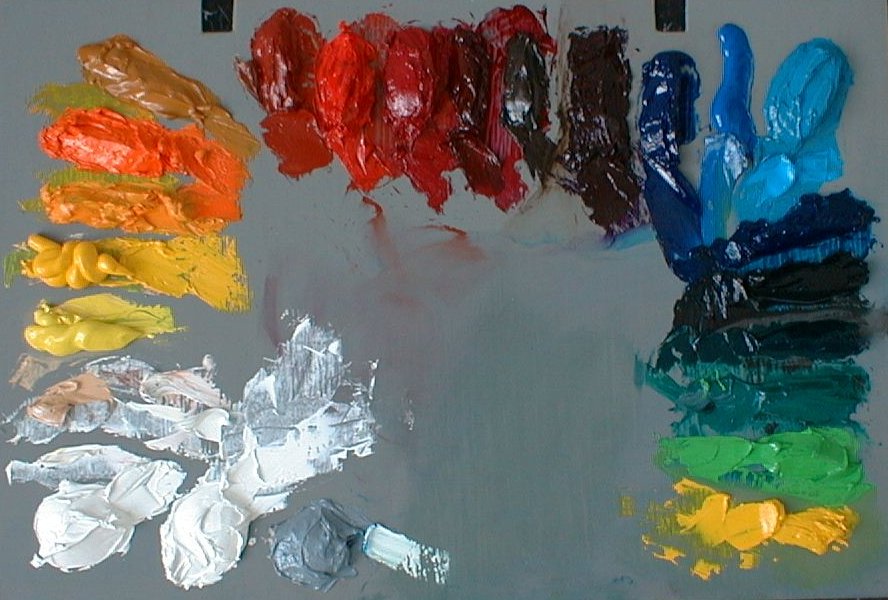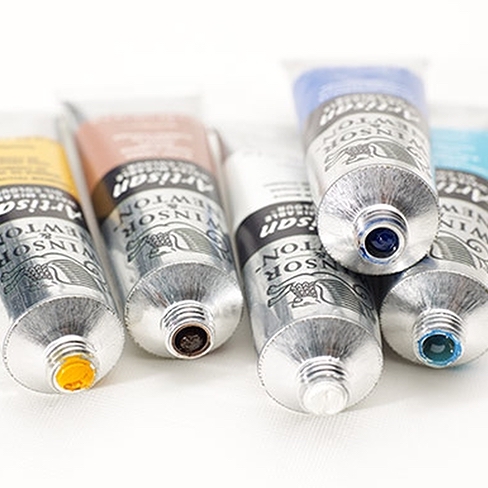There are lots of possible palettes of colors you can choose when you are painting, both in oils and acrylics, so how do you choose which oil painting palette is best? Here is a guide for how to choose oil colors that will help you select the best palette, depending on your skill level and what you want to paint.

Use this guide for different oil painting techniques or acrylic painting techniques. The tool also works for watercolors too.
This tool will step you through the process of selecting the best oil colors to use depending on various factors such as your level of expertise, and what you are trying to achieve.
How To Choose Oil Colors: Artist/Professional Grade Oil Paints or Student Grade Oil Paints – What’s the Difference?
When you are deciding how to choose oil colors, the main differences between artist and student grade paints are:
- Pigment strength and coverage (and amount of fillers). Artist grade oil paint can have twice the amount of pigment in the same volume of paint compared to a student grade. Student grades have more fillers. So if you are mixing a student grade paint with medium, you might need to use twice as much to get the same coverage of the color on your canvas. But since artist paints can cost up to ten times as much as student grade paints, this pigment content is not always relevant when choosing oil colors. You can afford to use twice as much paint because it is a lot less expensive.
- Pigment fillers and impasto applications Student grade paints have a lot more fillers, so they are actually good to use if you are doing a lot of impasto brushwork. The pigment strength issue is a lot more relevant when you are doing thin highly blended paintings like with some of the old master painting techniques. However since most painters like to take advantage of the extra interest you can get in your work with more expressive impasto brushwork, some students paints are just as good as artist grade paints and far less expensive. Since they are cheaper, it will encourage you to use more paint and you will get more expressive brushwork, compared to being stingy with the paint and creating a relatively uninteresting flat surface.
- Chemical composition. Artist grade paints often use more expensive pigments, and student grade paints use less expensive pigments.
For example, Cobalt Blue is an expensive pigment, so in the student grade version, called Cobalt Blue Hue (the word ‘hue’ tells you it’s not real cobalt blue), they use Phthalo (Phthalocyanine) Blue. Phthalo Blue is a lot less expensive. But this may or may not matter depending on how you intend to use the paint. In this case Cobalt Blue is a much less strong pigment when mixed with white or other colors, so it is easier to control and dull down. Phthalo blue however is a very strong pigment and retains saturation even when you add a lot of white and can overpower other colors if you are not careful. But in different circumstances, either one may be better. With yellows, I find the more expensive Cadmium Yellows are better to use than the less expensive Azo based yellows you often find in the students grade paints. With these cheaper alternative yellows, you need a lot of paint to modify other colors, and this can be a nuisance when painting
So the bottom line is student grade paints can in many circumstances be fine to use. Choose artist grade paints only where you need to strength of the pigments, and student grade paints in the other cases.
Knowledge in how to use colors from a compositional and harmony point of view is far more important to the end result than the quality of the paint. And using the paint more freely and expressively can lead to you exploring the color variations more and learning color harmony faster.
So the bottom lines is be a little wary when people tell you to only use artist grade paint. The real answer is: it depends.
P.S. Always look at the permanence of the pigments used. This is the amount of time it takes for the paint to lose its color. You definitely don’t want to buy student grade paints that have a low permanence rating if you are doing work that you are selling or want to keep for a long time. Most paints these days are relatively permanent so this is often not an issue. However, be sure to check it when you are choosing oil colors.
See also: palettes on Wikipedia.
